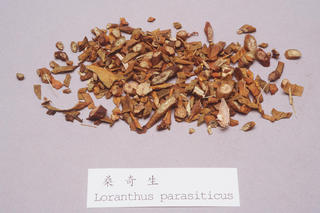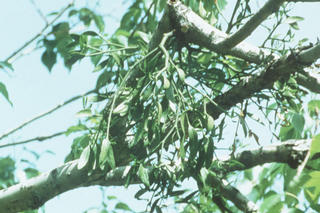Viscum coloratum
Contents
- 1 Nomenclature
- 2 Historical Use of Viscum coloratum
- 3 Background
- 4 Nomenclature
- 5 Historical Use of Viscum coloratum
- 6 Background
- 7 Nomenclature
- 8 Historical Use of Viscum coloratum
- 9 Background
- 10 Nomenclature
- 11 Historical Use of Viscum coloratum
- 12 Background
- 13 Pharmaceutical Information
- 14 Evidence or the Use of Viscum coloratum in the Treatment of Epilepesy
- 15 Safety
Nomenclature
Other Names:
Historical Use of Viscum coloratum
Viscum coloratum in Traditional Chinese Medicine
Background
Chinese Name (pinyin): Sangjisheng
Chinese Name :
Common Name :Mulberry Mistletoe
Specific Name : Herba taxilli
Scientific Name:
Collection :
Description :
Identification :
Processing :
Action : To replenish the liver and the kidney, to strengthen the tendons and bones, to relieve rheumatic conditions, and to prevent abortion.
Indication : rheumatic or rheumatoid arthralgia with aching and weakness of the loins and knees; abnormal uterine bleeding, excessive menstrual flow; uterine bleeding during pregnancy, threatened abortion; hypertension
Precautions :
Dosage : 9 to 15 g.
Storage : Preserve in a dry place, protected from moth.
Nomenclature
Other Names:
Historical Use of Viscum coloratum
Viscum coloratum in Traditional Chinese Medicine
Background
Chinese Name (pinyin): Hujisheng
Chinese Name :
Common Name :Colored Mistletoe Herb
Specific Name : Herba visci
Scientific Name:
Collection : The drug is collected from winter to spring, removed from wide stem, cut into section and dried or dried after steaming.
Description : Stems cylindrical, 2 - 5 branched, about 30cm long, 0.3 - 1cm in diameter, externally yellowish green, golden yellow or yellowish brown with longitudinal wrinkles, nodes swollen with branches or scars of branches, light texture fragile, easily broken, fracture uneven, bark yellow, wood pale yellow, rays radial, pith often inclined to one side. Leaves opposite on the tips of the branches, easily fallen off, sessile, lamina long elliptical, lanceolate, 2 - 7cm long, 0.5 - 1.5cm wide, apex obtuse, bas cuneate, margins entire, externally yellowish green with fine wrinkles, quinquenervis in the middle distinct. Texture leathery, berry spherical, crumpled, odorless taste slightly bitter, sticky on chewing.
Identification : 1.Transverse section of stem: Epidermal cells rectangular covered with yellowish green cuticle, 19 - 80µm thick. Cortex broader, fibres of several tens in bundles, slightly lignified, stone cells of old stem numerous, scattered singly or in groups. Phloem relatively narrow with stone cells scattered in old stems, cambium indistinct. Xylem rays with scattered fibre bundles, vessels surrounded by numerous fibres and few heterogeneous cells. Pith distinct, parenchymatous cells containing clusters of calcium oxalate and a few prisms.Powder of stem: Pale yellow, fragments of epidermis yellowish green, cells subsquare, stomata visible, fibres in bundles, 10 - 34µm in diameter, walls thickened, somewhat sinuous and slightly lignified. Heterogeneous cells irregular, walls thickened, slightly lignified with big lumen. Clusters of calcium oxalate 17 - 45µm in diameter. Few prisms, 8 - 30µm in diameter. Stone cells subsquare, subpolygonal or irregular, 42 - 102µm in diameter.2. To 1 - 2g in pieces add 30ml of ethanol, heat under reflux for 30 minutes, cool, filter. Evaporate the filtrate to dryness, dissolve the residue in 1ml and use it as the test solution. Prepare a solution of 1.5g reference drug of Herba Visci in same way as that described for test solution. Dissolve oleonolic acid CRS in absolute ethanol to produce a solution containing 1mg per ml as the reference solution. Carry out the method for thin layer chromatography (appendix Vl B) using silica gel G as the coating substance and a mixture of toluene-ethyl actetate glacial acetic acid (8:2:0.1) as the mobile phase. Apply separately 4µl of each of the test solution and the reference drug solution and 2µl of reference solution to the plate. After developing and removal of the plate, dry it in the air. Spray with 10% sulfuric acid in ethanol solution, heat at 80ºC until the colour of the spot appears clearly, examine under sun light and ultra violet light (365nm). A spot in the chromatogram obtained from the test solution correspond in position and colour to the spot in the chromatogram obtained from the reference solution and reference drug solution.
Processing : Eliminate foreign matter, wash briefly, soften thoroughly, cut into thick slices and dry.
Action : To relieve rehumatic conditions, to replenish the liver and the kidney, to strengthen the tendosn and bones, and to prevent abortion.
Indication : rheumatic arthralgia, aching and weakness of the loins and knees; threatened abortion
Precautions :
Dosage : 9 to 15 g.
Storage : Preserve in a dry place, protected from moth.
Nomenclature
Other Names:
Historical Use of Viscum coloratum
Viscum coloratum in Traditional Chinese Medicine
Background
Chinese Name (pinyin): Sangjisheng
Chinese Name :
Common Name :Mulberry Mistletoe
Specific Name : Herba taxilli
Scientific Name:
Collection :
Description :
Identification :
Processing :
Action : To replenish the liver and the kidney, to strengthen the tendons and bones, to relieve rheumatic conditions, and to prevent abortion.
Indication : rheumatic or rheumatoid arthralgia with aching and weakness of the loins and knees; abnormal uterine bleeding, excessive menstrual flow; uterine bleeding during pregnancy, threatened abortion; hypertension
Precautions :
Dosage : 9 to 15 g.
Storage : Preserve in a dry place, protected from moth.
Nomenclature
Other Names:
Historical Use of Viscum coloratum
Viscum coloratum in Traditional Chinese Medicine
Background
Chinese Name (pinyin): Hujisheng
Chinese Name :
Common Name :Colored Mistletoe Herb
Specific Name : Herba visci
Scientific Name:
Collection : The drug is collected from winter to spring, removed from wide stem, cut into section and dried or dried after steaming.
Description : Stems cylindrical, 2 - 5 branched, about 30cm long, 0.3 - 1cm in diameter, externally yellowish green, golden yellow or yellowish brown with longitudinal wrinkles, nodes swollen with branches or scars of branches, light texture fragile, easily broken, fracture uneven, bark yellow, wood pale yellow, rays radial, pith often inclined to one side. Leaves opposite on the tips of the branches, easily fallen off, sessile, lamina long elliptical, lanceolate, 2 - 7cm long, 0.5 - 1.5cm wide, apex obtuse, bas cuneate, margins entire, externally yellowish green with fine wrinkles, quinquenervis in the middle distinct. Texture leathery, berry spherical, crumpled, odorless taste slightly bitter, sticky on chewing.
Identification : 1.Transverse section of stem: Epidermal cells rectangular covered with yellowish green cuticle, 19 - 80µm thick. Cortex broader, fibres of several tens in bundles, slightly lignified, stone cells of old stem numerous, scattered singly or in groups. Phloem relatively narrow with stone cells scattered in old stems, cambium indistinct. Xylem rays with scattered fibre bundles, vessels surrounded by numerous fibres and few heterogeneous cells. Pith distinct, parenchymatous cells containing clusters of calcium oxalate and a few prisms.Powder of stem: Pale yellow, fragments of epidermis yellowish green, cells subsquare, stomata visible, fibres in bundles, 10 - 34µm in diameter, walls thickened, somewhat sinuous and slightly lignified. Heterogeneous cells irregular, walls thickened, slightly lignified with big lumen. Clusters of calcium oxalate 17 - 45µm in diameter. Few prisms, 8 - 30µm in diameter. Stone cells subsquare, subpolygonal or irregular, 42 - 102µm in diameter.2. To 1 - 2g in pieces add 30ml of ethanol, heat under reflux for 30 minutes, cool, filter. Evaporate the filtrate to dryness, dissolve the residue in 1ml and use it as the test solution. Prepare a solution of 1.5g reference drug of Herba Visci in same way as that described for test solution. Dissolve oleonolic acid CRS in absolute ethanol to produce a solution containing 1mg per ml as the reference solution. Carry out the method for thin layer chromatography (appendix Vl B) using silica gel G as the coating substance and a mixture of toluene-ethyl actetate glacial acetic acid (8:2:0.1) as the mobile phase. Apply separately 4µl of each of the test solution and the reference drug solution and 2µl of reference solution to the plate. After developing and removal of the plate, dry it in the air. Spray with 10% sulfuric acid in ethanol solution, heat at 80ºC until the colour of the spot appears clearly, examine under sun light and ultra violet light (365nm). A spot in the chromatogram obtained from the test solution correspond in position and colour to the spot in the chromatogram obtained from the reference solution and reference drug solution.
Processing : Eliminate foreign matter, wash briefly, soften thoroughly, cut into thick slices and dry.
Action : To relieve rehumatic conditions, to replenish the liver and the kidney, to strengthen the tendosn and bones, and to prevent abortion.
Indication : rheumatic arthralgia, aching and weakness of the loins and knees; threatened abortion
Precautions :
Dosage : 9 to 15 g.
Storage : Preserve in a dry place, protected from moth.
Synonymns for Viscum coloratum
Patent Medicines and Medicines with Multiple Ingredients that include Viscum coloratum
Pharmaceutical Information
Chemical Constituents
Evidence or the Use of Viscum coloratum in the Treatment of Epilepesy
Basic Science
Animal Studies
Cohort, Case-Control and Non-Randomized Trials
Randomized Controlled Trials
Meta-Analysis
1st Five Results: pubmed search
Yanfu Wang, Zhichao Hao, Dongxu Lu, Anam Naseem, Ye Sun, Yan Sun, Jianzhe Li, Haixue Kuang, Yan Liu, Bingyou Yang
Effects of Viscum coloratum (Kom.) Nakai on collagen-induced rheumatoid arthritis.
J Ethnopharmacol: 2024, 327;118026
[PubMed:38490288]
[WorldCat.org]
[DOI]
(I p)
Michelle Nonato de Oliveira Melo, João Vitor da Costa Batista, Evelyn Maribel Condori Peñaloza, Adriana Passos Oliveira, Rafael Garrett, Stephan Baumgartner, Carla Holandino
##Title##
Plants (Basel): 2023, 12(9);
[PubMed:37176869]
[WorldCat.org]
[DOI]
(P e)
Ruizhen Zhang, Rong Duan, Weiqing Wang, Zhiguo Yu, Yun Li, Yunli Zhao
Study on the dynamic variation of the secondary metabolites in Viscum coloratum using targeted metabolomics.
Chin J Nat Med: 2023, 21(4);308-320
[PubMed:37120249]
[WorldCat.org]
[DOI]
(I p)
Hye Jin Choi, So-Jung Park, You Na Choi, Soo-Dam Kim, Eun-Bin Kwag, Si-Yeon Song, Ji Hye Park, Jin Kyu Kim, Changon Seo, Jeong June Choi, Hwa-Seung Yoo
##Title##
Integr Cancer Ther: 2022, 21;15347354221118332
[PubMed:36154312]
[WorldCat.org]
[DOI]
(I p)
Rui-Zhen Zhang, Jing-Tao Zhao, Wei-Qing Wang, Rong-Hua Fan, Rong Rong, Zhi-Guo Yu, Yun-Li Zhao
##Title##
J Pharm Anal: 2022, 12(2);243-252
[PubMed:35582400]
[WorldCat.org]
[DOI]
(I p)

